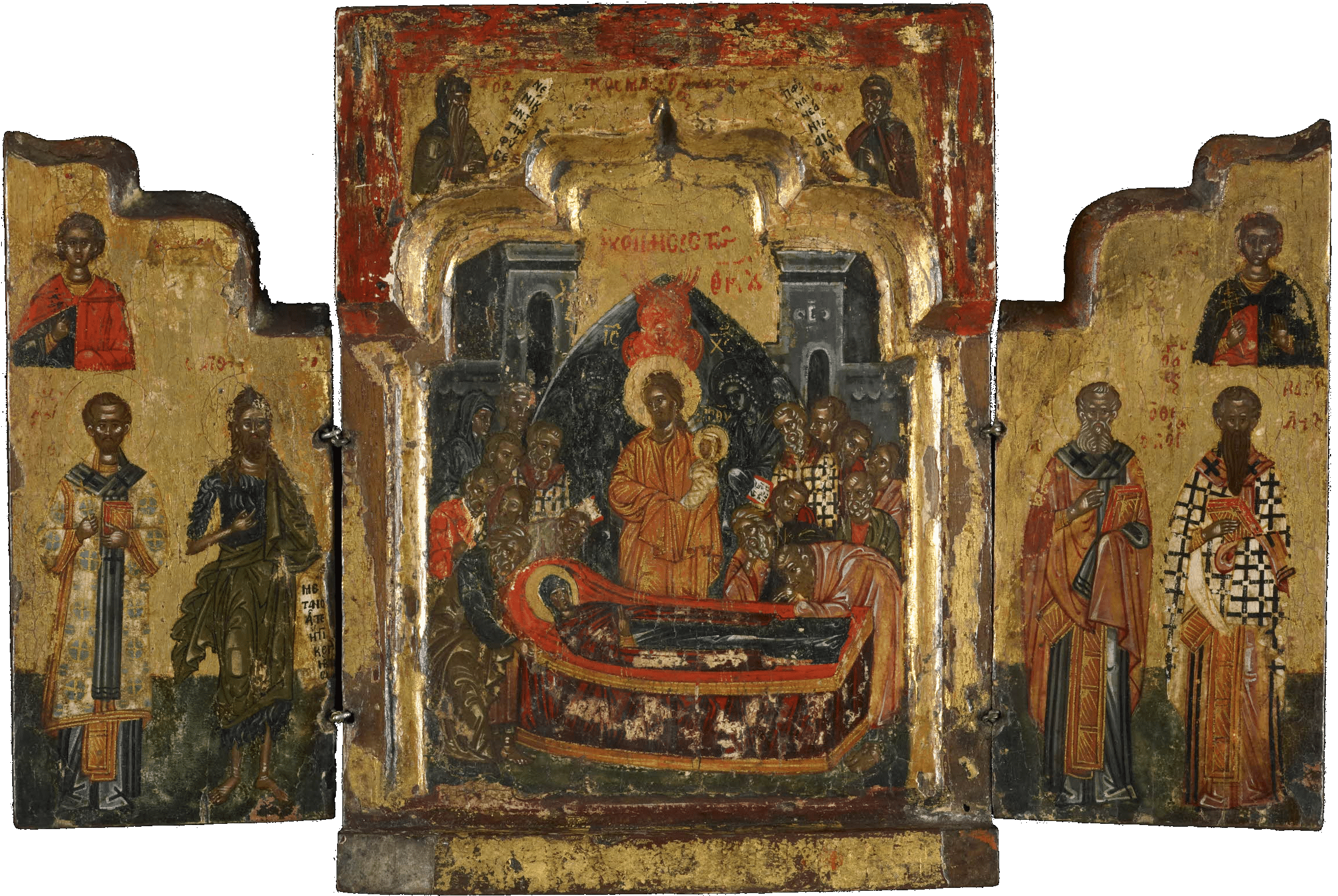The icon is painted in egg tempera with gold leaf on three wood panels primed with gesso over canvas. The central panel of the triptych has a depressed triple arch with a double moulding into which the two wings fit when the triptych is closed. The Dormition of the Virgin occupies the central panel with the inscription Η ΚΟΙΜΗCΙC ΤΗC Θ(ΕΟΤΟ)ΚΟΥ (‘the Dormition of the Virgin’) written in red capital letters on the golden background. Mary lies on a bier surrounded by apostles and two bishops. Christ holds her spirit in the form of a swaddled infant. Above him are an angel and a seraph. In the background are two buildings. On the spandrels above the Dormition, St Kosmas the Poet and St John of Damascus are shown bust length facing each other and holding open inscribed scrolls. Their names Ο ΑΓ(ΙΟ)C KOCMAC and Ο ΑΓ(ΙΟ)C Iω(ΑΝΝΗ)C Ο ΔΑΜΑCΚΗΝΟC are written next to them on the gold background. The scroll of St Kosmas has the inscription ΝΕΝΙΚΗCΕΝ ΤΗΝ ΦΥCΙΝ (‘outplayed the nature’) while that of St John of Damascus is inscribed: ΠΑΝΗΓΥΡΙCΑΤΕ ΠΑΝΤΕC CΥΝ…(‘celebrate everyone with. . .’). The left wing shows St John Chrysostom and St John the Baptist, full length, while St George is depicted bust length above St John Chrysostom. The right wing shows St Gregory the Theologian and St Basil, full length, and a bust of St Demetrios above St Basil. The back of the triptych is not painted.
Triptychs were designed for private devotions and this is clearly reflected in their shape and subject matter. A triptych could play the role of a domestic iconostasis inside the house of an individual, but could also be easily transported in order to escort and protect its owner on their travels. Not only individuals but also monasteries became serious commissioners of triptychs as the surviving examples indicate.
The Dormition of the Virgin has followed the iconography of the scene as it appears from the 15th century onwards in Cretan icons as, for instance, on two icons in the Museum of the Hellenic Institute in Venice (Kazanaki-Lappa 2005), which adopted and elaborated a well-known Constantinopolitan prototype used in key monuments of the 14th century, such as the Chora monastery built around 1320 (Underwood 1966). The representation of single saints either full length or bust length has also followed Cretan prototypes, such as, for example, those found in the work of Andreas Ritzos (c. 1421–92) and his son Nikolaos (documented 1482–1503). In a series of composite icons either signed or attributed to them we find the miniature-like quality that is also apparent in the BM triptych. For example, on the frame of the icon with the Ascension, the Preparation of the Throne, the Hospitality of Abraham and saints in the Tokyo National Museum of Western Art (Vassilaki 2010, 205–07, no. 51), which is signed by Andreas Ritzos, we find the prototype for the figure of St John the Baptist in the BM triptych. The busts of Sts George and Demetrios on the triptych are identical with those on the frame of an icon with the Virgin and Child between Angels, Saints and Christological Scenes in the Benaki Museum, Athens (Vassilaki 2010, 210–11, no. 53), which is attributed to Andreas Ritzos.
The BM triptych, however, though it follows the established Cretan iconography in its subject matter may not have been executed in Crete but on Mount Athos, as its woodwork indicates. The depressed triple arch with the double moulding is to be found in a series of triptychs, which are associated with Mount Athos. The closest to the BM example is one in the Museum of the City of Athens (Acheimastou-Potamianou 1987) dated to the end of the 16th century. A direct association with Mount Athos is implied by a 17th-century triptych in the Benaki Museum, Athens (Acheimastou-Potamianou 1988), as it includes two Athonite subjects—the Virgin Portaitissa on the central panel and St Paul Xiropotaminos on the left wing together with St Eleutherios on the right. As is well known, Cretan painting had reached Mount Athos not only through commissions but more importantly through the presence of native Cretan painters who were commissioned by major Athonite monasteries to execute fresco decorations and icons, such as in the case of Theophanes the Cretan, active on Mount Athos from 1535 till at least 1545–46 (Chatzidakis and Drakopoulou 1997).
Literature: P. Underwood, The Kariye Djami, New York, 1966, vol. 2, pl. 320; M. Acheimastou-Potamianou (ed.), From Byzantium to El Greco. Greek Frescoes and Icons (exh. cat., Royal Academy of Arts), London, 1987, no. 69; M. Acheimastou-Potamianou (ed.), Holy Image, Holy Space. Icons and Frescoes from Greece (exh. cat., The Walters Art Gallery), Baltimore, 1988, no. 79; D. Buckton (ed.), Byzantium: Treasures of Byzantine Art and Culture from British Collections (exh. cat., The British Museum), London, 1994), no. 237; M. Chatzidakis and E. Drakopoulou, Έλληνες ζωγράφοι μετά την Άλωση (1450-1830), Athens, 1997, 381–97; M. Kazanaki-Lappa, Guide to the Museum, Hellenic Institute of Venice, Venice, 2005, 40–1, nos 9–10; R. Cormack, Icons, London, 2007 (repr. 2014), 98, fig. 61, 117, no. 20; M. Vassilaki (ed.), The Hand of Angelos. An Icon Painter in Venetian Crete (exh. cat., The Benaki Museum), Athens, 2010.
Maria Vassilaki
